UPDATE!!! SCROLL DOWN TO READ TODAY'S SELECTED PUBLIC COMMENTS REGARDING SHADOW FLICKER AND WHY A FARMER REGRETS SIGNING ON WITH THE WIND DEVELOPERS OF THIS PROJECT. THIS PUBLIC COMMENTS WERE TAKEN FROM THE PSC DOCKET FOR THE GLACIER HILL WIND FARM PROJECT--
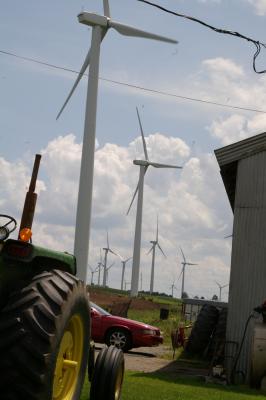 HOW CLOSE IS TOO CLOSE?
HOW CLOSE IS TOO CLOSE?
Each yellow circle below represents a home in the proposed Glacier Hills wind farm about 50 miles northeast of Madison.
The red dots are the proposed turbine sites.
This proposal has turbines that are 400 feet tall (40 stories) sited as close as 1000 feet-- that's about 350 steps--- from the doors of non participating homeowners.
This distance which was once assumed to be safe by both the wind industry and the PSC is now being called into question.
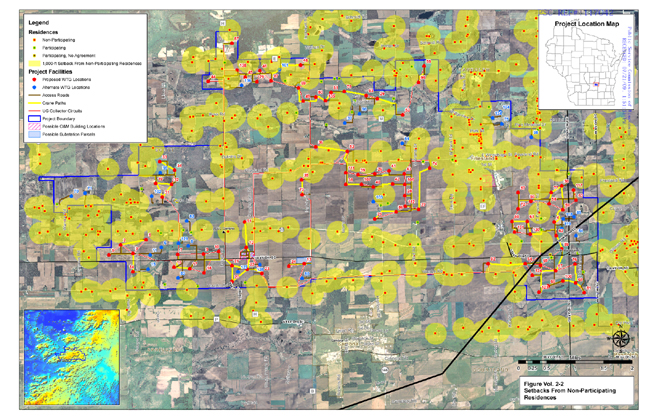
 [Download the full- sized map by clicking here]
[Download the full- sized map by clicking here]
[To learn more about this project and see close-ups of the proposed layout, click here]
The yellow circle that surrounds each home is the 1000 foot setback proposed by the developer. Though this setback allows the developer to get as many turbines into the project as possible, serious questions are being raised about the safety of this setback. Developers have not been able to provide any medical and scientific or medical data which supports this setback.
Recent scientific and medical reports find 2640 feet to be the minimum setback beyond which problems with noise and shadow flicker are not a major concern. However, many residents now living amid 400 foot turbines in our state are recommending setbacks that are even further from homes.
Our hope is the Public Service Commission will reconsider the 1000 foot setback and prevent the problems that plague many residents in the PSC-approved wind farms of Fond du Lac and Dodge Counties and require any setback distance to be based on the most current scientific and medical data.
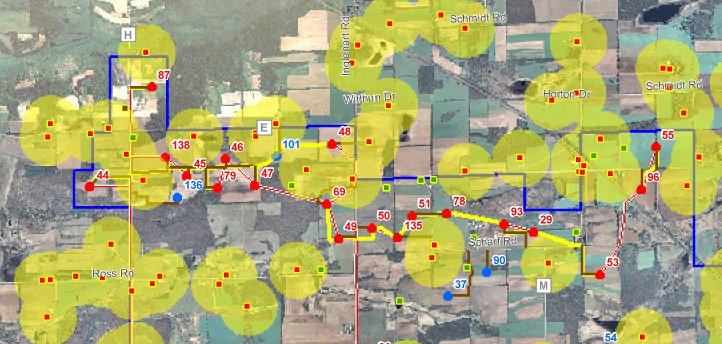 The Public Service Commission is now accepting public comments on this proposed project, its setbacks, noise limits, and other concerns. We hope you'll take a moment to contact them to let them know what you think about the setbacks proposed for this project and urge them to base the siting of wind turbines on scientific and medical data rather than the wind developers need to site as many turbines as posible in the smallest amount of space.
The Public Service Commission is now accepting public comments on this proposed project, its setbacks, noise limits, and other concerns. We hope you'll take a moment to contact them to let them know what you think about the setbacks proposed for this project and urge them to base the siting of wind turbines on scientific and medical data rather than the wind developers need to site as many turbines as posible in the smallest amount of space.
You can post your comment to the PSC by CLICKING HERE
You can also view the entire docket for the Glacier Hills Project at the PSC website [CLICK HERE]
Enter docket number 6630-CE-302 in the boxes and click "GO"
Scroll down to read selected public comments from this project. We will be adding them as they become available.
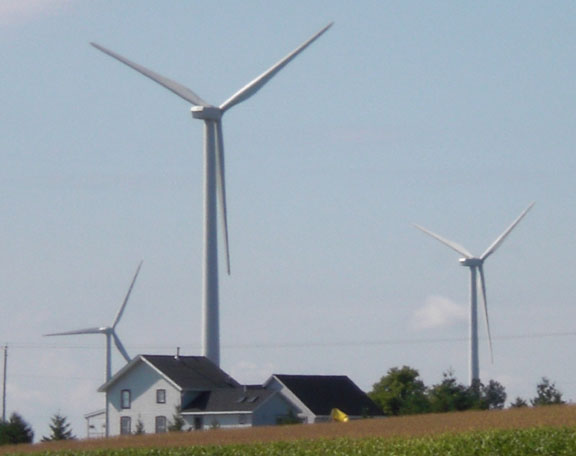 Home in Invenergy Forward Energy Wind Farm, Town of Byron, Fond du Lac County, Wisconsin. Summer, 2008
Home in Invenergy Forward Energy Wind Farm, Town of Byron, Fond du Lac County, Wisconsin. Summer, 2008
TODAY'S SELECTED PUBLIC COMMENT on WHY FARMER REGRETS SIGNING ON WITH WIND DEVELOPER FOR THE GLACIER HILLS PROJECT:
In 2004 I signed my farm corporation with Florida Power and Light in a wind farm easement.
At that time the present land values and commodity prices made the turbine lease payments seem very attractive.
I was assured the project would be similar to the straight line configuration near Montfort, WI, with similar sized turbines.
Four years went by and very little was ever mentioned about the project. It was suggested by PFL personnel that the project was ‘dead’ and not going to be built.
Suddenly in 2008 FPL and WE Energies announced the sale of the project and purchase by WE Energies.
Landowners were given no choice in the matter to cancel their agreements.
The plan today that WE Energies proposes is not the plan many of us originally signed for.
400 foot turbines, 1000 feet from non-participant homes for 30-40 years was not anticipated by any landowner.
It is now necessary and ethical to consider how our choices and actions impact others.
Credible evidence exists of adverse health effects, devaluation of property values, and irreparable community social damage. Live long friendships have already been severed.
Many outspoken proponents of wind development in this area live miles away from the turbines proposed on their property. Yet they are perfectly willing to allow turbines 1000 feet from non-participating neighbors. One has even said he would not want a turbine next to his house.
WE Energies has personnel “camped out” in the Friesland Village Apartments. They act very pleasant and understanding, yet consider they are highly paid to do so, and when move on to the next community when their job here is done.
I and many others are sick and tired of their presence and wonder how they sleep well knowing so many people in the area oppose the project.
Renewable energy is needed. The enormous tax dollars being spent should be put to use on sustainable sources such as manure or bio-mass digesters, not inefficient, irrational, gigantic turbines that only produce energy when and if the wind blows.
This summer alone, think about how many days meaningful electricity would have been produced. The entire summer the proposed turbines would have used more electricity in the computer controls, lighting beacons at night and operations and management than they would have ever produced.
The electricity they produce is not, and never will be free. Think of the carbon footprint created just in construction and continued maintenance of this project.
Money and greed motivates all of us, but may be a weak justification to the consequences of a project of this magnitude.
It is for these reasons I strongly oppose this project and sincerely regret signing a wind developers contract.
Steinich Farms
Cambria, WI
TODAY'S SELECTED PUBLIC COMMENT on SHADOW FLICKER
From Cathy Bembinster
Town of Union:
I would like to make a comment about the Shadow Flicker Study.
In the “Shadow Flicker Study for the Glacier Hills Wind Energy Project, CSRP0005-BCONFIDENTIAL October 1, 2008 on page 1, under “Shadow Flicker Overview”, there is a paragraph that states:
“Shadow flicker caused by wind turbines is defined as alternating changes in light intensity due to the moving blade shadows cast on the ground and objects, including windows at residences. The influence of shadow flicker on residences depends on the length and direction of shadows cast by wind turbines and the relative location of wind turbines and windows at the residence”.
On page 2, under “Shadow Flicker Analysis”, we find this paragraph:
“To address shadow flicker generally, theoretical houses have been assumed to be located at eight compass points around a representative turbine, as illustrated in Figure 1. Using the WindFarm software, two separate models were built with houses at distances of 600 ft (183 m) and 1000 ft (305 m) from the turbine, representing the We Energies setback distances to participating and non-participating land owners.
Each house is assumed to have a 1-m square window facing the turbine, centered 2 m above ground level.
The model was run with an 80-m hub height and an approximately 93-m rotor diameter, which is representative of the Siemens S2.3, the largest size turbine under consideration for the Glacier Hills project.
Results will be approximately the same over the range of turbines under consideration for the project. The results assume the turbine is always yawed to face the sun, maximizing the shadow flicker area. The results also assume flat ground and do not take other structures or terrain influences into account.2
2 Specific results that do incorporate the terrain and trees around a particular turbine can be derived; this results in a different pattern for each turbine. The generalized flat terrain provides typical results.”
Let’s recap:
Shadow flicker caused by wind turbines is defined as alternating changes in light intensity due to the moving blade shadows cast on the ground and objects, including windows at residences.
The influence of shadow flicker on residences depends on the length and direction of shadows cast by wind turbines and the relative location of wind turbines and windows at the residence.
The wind developer instructs their consultant to take into consideration the health and safety of the public by ignoring individual non-participating landowner’s properties, the specifics of the ground and objects, and just runs the shadow flicker model against a THEORETICAL 1 meter by 1 meter (3ft. X 3 ft.) window on a THEORETICAL house around a THEORETICAL wind turbine.
This may explain why there’s a problem with shadow flicker in the existing Wisconsin Wind Farm projects.
http://www.youtube.com/watch?v=MbIe0iUtelQ
The study continues and includes “Possible Mitigation” on page 6:
“DNV-GEC could at additional cost study shadows cast on specific residences. Such an analysis would incorporate elevation differences and yield recommendations for possible mitigation techniques, such as planting a tree in front of a window or installing high opacity blinds.”
In a recent white paper from the Minnesota Department of Health, Public Impacts of Wind Turbines, May 2009, http://legalectric.org/f/2009/06/mndepthealth-windwhitepaper.pdf, the health department decided to run their own shadow flicker model. Here are their conclusions.
“Shadow Flicker
Rhythmic light flicker from the blades of a wind turbine casting intermittent shadows has been reported to be annoying in many locations (NRC, 2007; Large Wind Turbine Citizens Committee, 2008). (Note: Flashing light at frequencies around 1 Hz is too slow to trigger an epileptic response.)
Modeling conducted by the Minnesota Department of Health suggests that a receptor 300 meters perpendicular to, and in the shadow of the blades of a wind turbine, can be in the flicker shadow of the rotating blade for almost 1½ hour a day.
At this distance a blade may completely obscure the sun each time it passes between the receptor and the sun. With current wind turbine designs, flicker should not be an issue at distances over 10 rotational diameters (~1000 meters or 1 km (0.6 mi) for most current wind turbines).
This distance has been recommended by the Wind Energy Handbook (Burton et al., 2001) as a minimum setback distance in directions that flicker may occur, and has been noted in the Bent Tree Permit Application (WPL, 2008).
Shadow flicker is a potential issue in the mornings and evenings, when turbine noise may be masked by ambient sounds. While low frequency noise is typically an issue indoors, shadow flicker can be an issue both indoors and outdoors when the sun is low in the sky. Therefore, shadow flicker may be an issue in locations other than the home.
Ireland recommends wind turbines setbacks of at least 300 meters from a road to decrease driver distraction (Michigan State University, 2004). The NRC (2007) recommends that shadow flicker is addressed during the preliminary planning stages of a wind turbine project.”
[click on the image below to watch a video of shadow flicker problems in homes in Dodge and Fond du Lac Counties]
Filed 8/11/09 by Nic Ludwig, Sauk City, WI:
The #1 problem with industrial size wind turbines, which are 400 feet tall or taller, is that they are placed too close to people's homes.
Research has proven that industrial wind turbines should be placed at least 2,640 feet away from people's homes to minimize the health and safety issues that are associated with them.
I am not saying wind farms can't or shouldn't exist, but I am saying industrial wind turbines need to be placed at least 2,640 feet away from people's homes.
The concerns of people who currently live in or near an industrial wind farm (and people who will be affected by wind farms in the future) NEED TO BE TAKEN SERIOUSLY! You can not let the propaganda of wind developers and lobbyists for wind influence your decisions.
Due to improper placement, many people living in or near an industrial wind farm are experiencing health and safety problems.
Living too close to an industrial wind turbine has caused health problems among people due too much noise and shadow flicker, which is a strobe-like flashing of light flickering into homes.
It has also hurt property values. People living in or near an industrial wind farm can no longer sell their homes. This is why within the last year several Wisconsin towns and counties have developed ordinances after conducting countless hours of extensive research into problems arising from industrial wind farms that are being reported on an international scale.
The research clearly demonstrates that industrial size wind turbines that are placed closer than 2,640 feet setback from people's homes result in a multitude of health problems not to mention safety issues from ice throws, splintered blades and tower collapse from lightning strikes.
There have been several lightning strikes already documented at the Blue Sky, Green Field project in northern Fond du Lac County which recently went on line. Thankfully the incidents were not catastrophic yet. I am asking you to please stop allowing industrial wind turbines 1,000 feet from people's homes.
Calumet County, Wi has an ordinance that was developed by an Ad hoc Committee, which was composed of 12 members (4 members for, 4 against, and 4 unbiased members). County Board members used this committee's research over several months to come up with a County ordinace, which includes a sound ordinance.
Wind developers are not happy with the ordinaces because they feel it is too strict and has slowed projects.
Why is the in-depth research of local towns and counties being questioned and not the wind companies for wanting to push these projects through? When it comes to the health and safety of local residents shouldn't ordinances be strict? Addressing the HEALTH AND SAFETY OF LOCAL RESIDENTS SHOULD BE THE#1 PRIORITY and everything else should come second.
The Blue Sky Green Field Wind Farm located in Fond du Lac County borders Calumet County. This project has caused major issues amongst local residents. I would strongly encourage you to take a drive up to this wind farm and experience first hand what it would be like to live in or near an industrial wind farm.
Talk with some of the local residents regarding their concerns. First-hand knowledge is way better than hear-say. I would also encourage you to talk with Senator Joe Leibham who has visited this wind farm and has talked with local residents about their concerns.
This project, along with other projects in the state have on-going issues with wind turbines being too close to people's homes causing many health and safety issues. I strongly recommend you check out this website: http://betterplan.squarespace.com/, which explains very well the many issues with industrial size wind turbines being too close to people's homes.
While legally ordinances can only address health and safety concerns, there are other issues including interference of radio, television, and broad band reception.
Why are wind developers able to create vast areas of ‘dead zones’? Are not the people living in these areas entitled to the same rights and privileges as the rest of the population?Shouldn’t they have access to the same sources of media that everyone else has?
Shouldn’t they have access to "Flight for Life” like everyone else? Why should they have to transport an accident victim to a ‘safe zone’ so the victim can then be transported via air to a near-by hospital? One elderly woman in the Johnsburg area tearfully stated at a recent town hall meeting that she and her husband have been given ‘a life sentence’ to have to live in this project. They are too old to move and have no desire to sell their house even if they could.
The concerns of people who currently live in or near an industrial wind farm (and people who will be affected by wind farms in the future) NEED TO BE TAKEN SERIOUSLY! PLEASE KEEP INDUSTRIAL WIND TURBINES AT LEAST 2,640 FEET OR MORE AWAY FROM PEOPLE'S HOMES.
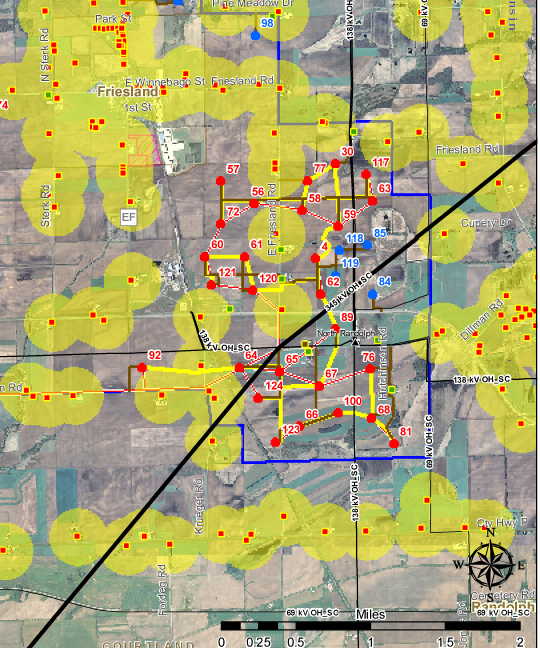
PSC REF#: 118213
Public Comment by Lynda Barry
Docket or Case Concern: 6630- -0
Submission Date: 8/11/2009 8:28:22 PM
Comment Detail:
RE: Wind Turbines and EMS helicopters in Wisconsin
This interview with retired EMS pilot Ray Slavik, was submitted to the Calumet County Ad Hoc Committee researching proposed ordinances governing the placement of wind turbines in the county.
The interview provides important insight into controlling an aircraft in the vicinity of utility-scale turbines.
Ray Slavik is a retired EMS Pilot who has flown for 20 Years as a pilot before retirement.
He is currently working as instructor for new helicopter pilots, checks pilot flight capabilities for insurance companies and completes pilot certification. He has also has a fixed wing pilots rating for both private and commercial aircraft.
He was employed as an EMS pilot in Buffalo New York for about 2 years, than transferred to work as a relief pilot throughout WI.
Mr. Slavik worked for Theda Clark Hospital as an EMS pilot for over 16 years making numerous EMS flights into and out of Calumet County before retirement. He has also served as a pilot for the search and rescue helicopter service in Green Bay and the surrounding counties.
The interview was conducted by Daniel Hedrich, the Co-Chairman for the Township of Chilton's Wind Energy Systems advisory committee:
Dan Hendrich: We opened our conversation with Ray asking, “Why is this information important to you and who has asked to get this information?”
I explained to Ray that I am a Co-Chairman for the Township of Chilton's WES advisory committee and also a member of the Calumet County Ad Hoc committee appointed to help the county review and come up with information and recommendations on proposed Ordnances and any changes that may need to be made. I have been appointed by the Chairman of the Calumet County Board and
also Chairman of the Ad Hoc committee to research the EMS flight information.
Q: Do you feel that an EMS pilot would be able to land near a Large Wind Turbine if they shut them off?
Ray Slavik: Don't kid yourself, they will most likely not land anywhere in the County where these turbines are located, I have arrived at many accident scenes before the
sheriffs dept. We (helicopter and crew) are often ¾ of the way to an accident scene before the sheriff's Department or other people in authority arrive on the scene.
The 1st responders often make the first call and we are on the way. Time is the important issue and that is the reason for the EMS flights. The sooner we arrive for transport the better the chance of saving that life.
Remember the reason we are there is to be able to transport the patient to the nearest Trauma Center as quickly as possible. If the patient needs to be transported by ground to
a location free of Turbines or to the Calumet Medical Center instead of direct pick up from the accident scene valuable time is lost and that is what the EMS helicopter program is all about.
Q: What are the EMS flight regulations for maximum altitude when flying into Calumet County because of all of the current air traffic?
A: EMS ceiling for Flight: they may go as high as 10,000 ft. Above that oxygen isneeded, which is not carried on board. Current part 135 of the FAA regulations require ½ mile of ground visibility and a 300 foot ceiling. However the operation specifications for each flight program is usually higher than FAA minimums. If the visibility or ceiling falls below the operational specifications for that flight program the pilot cannot legally accept the flight.
A pilot would need a minimum of 500 feet above a known object to fly safely over it. So if an object is 500 feet tall an EMS helicopter would need to be 1,000 feet off the ground to fly over it. This would limit flights to days when there is a cloud ceiling of 1,000 feet or greater.
The FAA regulations allow for flight with a ceiling of 300 feet, this would greatly limit the available days for Flights into and out of the Chilton Hospital.
Pilots are more comfortable flying over areas that they know obstruction heights day and night, however they are limited by their operation specifications on how low they can fly. Other factors depend on the type of weather such as low cloud ceiling verse rain, sleet or snow.
When flying VFR (Visual Flight Rules) in a helicopter it is important to have visual clues at all times. The books say that if you lose control of the helicopter because of clouds or visibility you would have about 20 seconds to gain control and fly by the instruments.
The flight weather reports are only good for 5 nautical mile radius of the airport which is giving out that information. As a pilot you don't know what may be out further in your route. You may leave knowing you have good flight data but the weather may change and push you closer and closer to the ground as you are flying.
I have often left my home base when the weather is ok but had to spend 3 to 5 hours on the ground waiting for a baby with health problems to be born so I can transport them to a neonatal center. Do you want to be the one who has to tell the parents why their child is going to die? Because you can't fly into an area anymore to safely pick them up.
Q: What type of effect would this turbulence have on a helicopter?
A: Being that the lift is provided by the large overhead rotor, the tail rotor counteracts the torque of the main rotor which keep the aircraft flying straight Any interference with the tail rotor system could cause the aircraft to yaw left or right or even spin. Since it would be most affected by turbulence from the side of the aircraft, your corridor must be wide enough so that any turbulence side would not have any adverse affect on the tail rotor.
If the turbulence did affect it, your aircraft would start to spin in rotation with the large overhead rotor causing a major loss of flight control. Turbulence will also affect the main rotor. It is this large rotor that provides the lift, but it does not do this by rotating on a level plan. The rotors flap as they rotate around the center or hub. It is this flapping that causes the lift that allows the helicopter to fly.
If turbulence interferes with this it would cause the helicopter to lose it's lift and it's ability to remain in the air. Enough turbulence will cause you to lose control of the aircraft.
Q: What distance is needed to make a safe normal speed turn?
A: That would depend on several factors, on a clear day with very little wind a 30 degree bank turn may require only ¼ to ½ mile to make. But when you are affected by low visibility from a low cloud ceiling or it is night time you would be required to make a more gentle turn to keep from losing altitude and your visible horizon location.
This would require that a maximum 20 degree banked turn be made. This turn would require at least a ½ mile of safe clearance to safely turn the aircraft around. Other factors such as bad weather conditions may require an even larger area.
If you get disorientated due to low visibility, low ceiling height and/or turbulenceand you lose the horizon you have 20 seconds to get your craft under control or it will crash.
Q: What other problems would these turbines present to an EMS pilot?
A: I have often used the (Night Sun light) on my helicopter to locate an obstacle or tower to be able to fly in close to make a safe landing or have safe passage around it.
The problem with the Wind Turbine is the turbulence would not allow you to fly in close enough to use the (Night Sun light) to properly navigate and protect your own life, as well as those you are responsible for aboard your aircraft.
Q: What about the way that the warning lights are designed on the Wind Turbines?
A: I have studied how these are placed in the FAA manuals and have a great concern about how these lights are place. They are placed at the top of the tower on the generator housing and than a blade can extend 100 to 200 feet beyond this without any lighting showing their maximum height. It would be impossible to make a safe passage through an area where there could be 50 or 100 of these
Wind Turbines.
So it could become a no fly zone for on the scene EMS helicopter services. This would limit EMS helicopter transports through such an area. This same problem would happen if a low cloud ceiling height did not provide enough safe clearance over the rotor tips. I would say this would require at least 500 to 600 feet of clearance above the rotor tips...
Q: What would be your perspective on this issue?
A: I would compare this to my experience of many on site EMS helicopter transports from rural car accidents scenes.
Often when you have an uncontrolled intersection in the country and there are a series of accidents there, you will then turn around and put up a stop sign to solve the problem. I have been unable to find any data that supports the fact that these Turbines would not cause any problems, so think about putting up that stop sign before the accident happens.
Look at protecting what you currently have as far as the EMS services are concerned.
Q: With the information that you have been provided with on the current size and type of wind turbine, what would you consider to be a safe travel
corridor width needed to allow for the EMS helicopter service to safely fly to and from Calumet Memorial Hospital?
A: One Nautical Mile would be to narrow. It would not allow for safe flight path even down the middle because of the influence of turbulence created by the Wind Turbines on either side. Even without the influence that air turbulence would have on the aircraft. You must provide room for safe travel, as well as to allow for a safe normal speed turn to be made. I would say that a clear flight path corridorshould be a minimum of 1 ½ nautical miles, with 2 miles being the preferred distance.
Q: With your experience as an EMS Helicopter pilot for almost 20 years in Calumet County, where would be the best area to establish a clear flight path for EMS Helicopter service to and from Calumet Memorial Medical Center?
A: Since most of your flights are coming from and then returning to Theda Clark Hospital in Neenah you should look at establishing this path around the North end of Lake Winnebago to the hospital in Chilton. Since a large portion of your county could be removed from the accident scene pickup. You should also look at establishing alternate sites where the patient can be ground transported to and
then airlifted to the Trauma Center at Theda Clark hospital or Milwaukee.
These Sites would require that a safe flight corridor either extending from the one at Calumet Hospital or others be set aside.
Q: What about establishing a safe flight path from Chilton to the South county line to provide for EMS transportation to Milwaukee, such as Froedert Hospital or St Mary's Burn Center as is currently done?
A: Since the flight would be longer the pilot would need much better flying conditions and than what is needed on a flight to and from Theda Clark the need for a safe corridor is reduced. If anything you could establish this safe flight path to New Holstein and the pilots could use it if needed. This could also provide for a safe flight path to be used when establishing alternate EMS pickup sites.
Then patients could be ground transported there and picked up by EMS helicopter for transport.
Q: Why does it seem that the whole EMS helicopter program has had a gag order and no information is now available to us to make a safe and knowledgeable decision on the safe flight corridor issue?
A: The problem is these hospitals make a lot of money from these flights and the pilots and crews are contracted from outside service providers. The hospitals do not want to lose any revenue, so they will not say anything. The company that provides the pilots and crews will not say anything, because they do not want the hospital to look for another EMS provider. This leaves everyone including the
pilots who have to do the flying with a gag order or they could lose their job.
My experience with flying as an EMS pilot is: If you as a pilot had a problem with flight or landing zones, the hospital will turn a deaf ear to you and will be angry about any complaints because you are paid to fly. The money comes in when you fly your aircraft.
Respectfully submitted,
Ray Slavik
EMS Helicopter pilot retired
Daniel Hedrich
Calumet County Ad Hoc Committee
November 5, 2007
